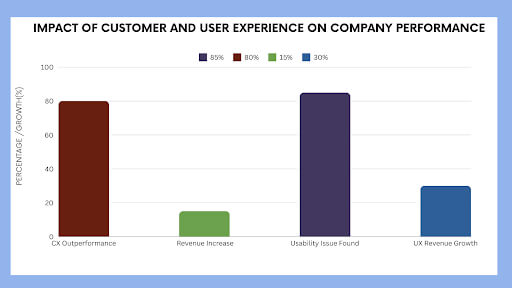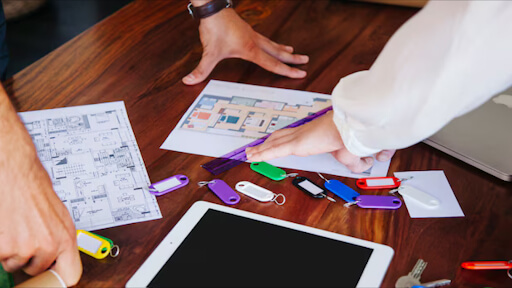 1-800-805-5783
1-800-805-5783 
A significant user experience research is no longer a luxury; it’s a necessity. By understanding your users’ needs, preferences, and behaviors, you may create goods that appeal to them and help businesses succeed. According to McKinsey, the companies with leading customer experience outperform the others by 80%.
User experience research is a critical component of product development. It enables businesses to create products that function effectively and provide a seamless and enjoyable user experience.
This blog post will explore user experience research and its importance in product development. We’ll discuss why it matters and how it can help you create products your users love.
So, what is user experience research? It’s like putting yourself in your customers’ place. According to Forrester Research, customer experience can increase revenue by 15%. By understanding their needs, preferences, and behaviors, you can design products that truly delight them.
But why is user experience research so important?
So, how does user experience research work?

In designing a successful user experience research study, you should gain deep knowledge regarding your target users’ needs, goals, or motivations. This will be achieved through different research methods, such as interviewing, surveying, observations, or the development of user personas.
Have you ever wondered how to truly understand your users?
Investing in user experience research is an investment in the success of your product, not just a cost. Ensuring that your product is created with the user in mind and has a higher possibility of success in the market is like laying a solid foundation for your business.
Wireframing and Prototyping
Wireframing means drawing low-fidelity representations of a product’s interface, often emphasizing layout and structure. This process is about creating more detailed, interactive mock-ups of the product, with which users can engage and comment on the design.
Advantages of wireframing and prototyping:
Problems found early in usability: Nielsen Norman Group research reveals that 85% of issues are found during usability testing at an early design stage.
Usability Testing
Usability testing is a methodology wherein real users are observed while they use a product or a prototype to identify usability issues and gather feedback.
Types of usability testing:
Moderated Usability Testing: Here, a facilitator assists the users with specific tasks and tracks the behavior.
Unmoderated Usability Testing: Users are asked to finish some task in their own time in an unmoderated testing session without a facilitator, but in this case, too, the latter checks their behavior through some survey or other means.
A/B Testing: While comparing the version of a product, decide which one performs better.
Iterative Design and Testing
Iterative design is an ongoing process based on user input and testing results. Thus, this development allows more agility and flexibility in ensuring that the end product satisfies the users’ requirements and expectations.
Benefits of iterative designs
Improved product quality: A McKinsey study reported that companies prioritizing user experience have revenue growth 30% higher than their competitors.

To track user experience research methods, one must measure and analyze key performance indicators to ascertain a product or service’s performance. For instance, these metrics explain some critical user behavior, how they react to a product or service, and their percentage of satisfaction.
User Acquisition and Retention KPIs of UX
Measure user acquisition by the number of new users for the product or service. User retention is the percentage of users who use the product or service as time passes.
Bain & Company research reveals that companies with high NPS scores experience revenue growth 2.5 times as great as those with low NPS scores.
A/B Testing
A/B testing compares two variations of a feature or product using a solid comparison method to see which performs better. Businesses can decide the best design or message by randomly sending users to other variations and then gauging the behavior.
Key benefits of A/B testing
Surveys of User Satisfaction
User satisfaction surveys are one of the feedback tools that companies use directly from customers. They help companies realize to what extent their users are satisfied with a particular product by asking related questions. Through them, companies can determine the scope for change and measure variations’ effects.
Critical Characteristics for Effective Surveys of User Satisfaction

For effective UX research, users should be engaged throughout the product development process, be involved in ongoing feedback, and ensure that the product meets user expectations and needs.
Nielsen Norman Group stated that early User Involvement saves around half of any project’s development cost.
Hybrid approach: According to a study by Nielsen Norman Group, conducting multiple research methods to combine the results can guarantee that the research’s outcomes will be more accurate and valid. Analytics: According to a McKinsey study, data-driven decisions are five times more likely to be market leaders.
Action and Analysis After Doing Research
Analysis of the findings is done for follow-up action for the improvement of the product from research data. This could include:
Based on such best practices, businesses can perform excellent UX research, which eventually becomes a product that suits the needs and expectations of users.
Airbnb, the popular online marketplace for vacation rentals, has extensively used UX research to improve its platform. By conducting user interviews, surveys, and usability testing, Airbnb has been able to:
Data and Statistics:
Slack, the famous team communication platform, has leveraged UX research to drive its growth and success. Through user interviews, surveys, and A/B testing, Slack has:
Data and Statistics:
While UX research can be a valuable tool, it is essential to learn from past mistakes to avoid common pitfalls. Here are some lessons learned from failed UX research projects:
By avoiding these common pitfalls and learning from past mistakes, businesses can conduct effective UX research that leads to successful product development.

User experience (UX) research is critical to successful product development. By understanding user needs, preferences, and behaviors, businesses can create products that are not only functional but also enjoyable and intuitive to use.
User experience research involves various activities, including wireframing, prototyping, usability testing, and iterative design. By conducting these activities, businesses can identify and address potential usability issues early in development, ensuring that the final product meets user expectations.
Case studies and real-world examples demonstrate the benefits of user experience research. Airbnb and Slack have successfully leveraged user experience research to improve their products and drive growth. However, it is essential to learn from past mistakes and avoid common pitfalls such as insufficient resources and biased research questions.
Businesses can create products that meet and exceed user expectations by prioritizing user experience research and incorporating it into product development. This can increase user satisfaction, drive customer loyalty, and pave the way for long-term success.
[x]cube LABS’s teams of product owners and experts have worked with global brands such as Panini, Mann+Hummel, tradeMONSTER, and others to deliver over 950 successful digital products, resulting in the creation of new digital revenue lines and entirely new businesses. With over 30 global product design and development awards, [x]cube LABS has established itself among global enterprises’ top digital transformation partners.
Why work with [x]cube LABS?
Our co-founders and tech architects are deeply involved in projects and are unafraid to get their hands dirty.
Our tech leaders have spent decades solving complex technical problems. Having them on your project is like instantly plugging into thousands of person-hours of real-life experience.
We are obsessed with crafting top-quality products. We hire only the best hands-on talent. We train them like Navy Seals to meet our standards of software craftsmanship.
Eye on the puck. We constantly research and stay up-to-speed with the best technology has to offer.
Our CI/CD tools ensure strict quality checks to ensure the code in your project is top-notch.
Contact us to discuss your digital innovation plans, and our experts would be happy to schedule a free consultation.